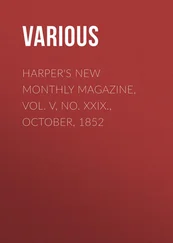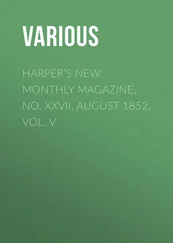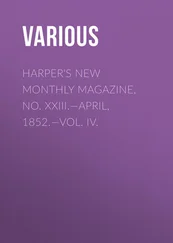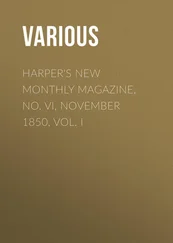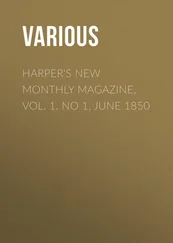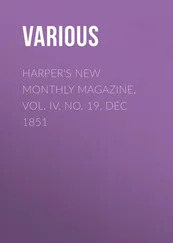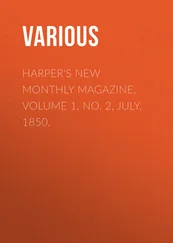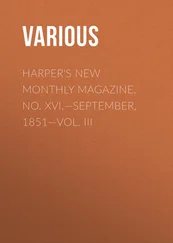Various - Harper's New Monthly Magazine, No. XXVI, July 1852, Vol. V
Здесь есть возможность читать онлайн «Various - Harper's New Monthly Magazine, No. XXVI, July 1852, Vol. V» — ознакомительный отрывок электронной книги совершенно бесплатно, а после прочтения отрывка купить полную версию. В некоторых случаях можно слушать аудио, скачать через торрент в формате fb2 и присутствует краткое содержание. Издательство: Иностранный паблик, Жанр: periodic, foreign_edu, на английском языке. Описание произведения, (предисловие) а так же отзывы посетителей доступны на портале библиотеки ЛибКат.
- Название:Harper's New Monthly Magazine, No. XXVI, July 1852, Vol. V
- Автор:
- Издательство:Иностранный паблик
- Жанр:
- Год:неизвестен
- ISBN:нет данных
- Рейтинг книги:4 / 5. Голосов: 1
-
Избранное:Добавить в избранное
- Отзывы:
-
Ваша оценка:
- 80
- 1
- 2
- 3
- 4
- 5
Harper's New Monthly Magazine, No. XXVI, July 1852, Vol. V: краткое содержание, описание и аннотация
Предлагаем к чтению аннотацию, описание, краткое содержание или предисловие (зависит от того, что написал сам автор книги «Harper's New Monthly Magazine, No. XXVI, July 1852, Vol. V»). Если вы не нашли необходимую информацию о книге — напишите в комментариях, мы постараемся отыскать её.
Harper's New Monthly Magazine, No. XXVI, July 1852, Vol. V — читать онлайн ознакомительный отрывок
Ниже представлен текст книги, разбитый по страницам. Система сохранения места последней прочитанной страницы, позволяет с удобством читать онлайн бесплатно книгу «Harper's New Monthly Magazine, No. XXVI, July 1852, Vol. V», без необходимости каждый раз заново искать на чём Вы остановились. Поставьте закладку, и сможете в любой момент перейти на страницу, на которой закончили чтение.
Интервал:
Закладка:
Now although in these cases the workman was always accustomed to take his position at the wheel in such a manner as to be exposed as little as possible to the effects of it, yet the air of the apartment, it was found, soon became fully impregnated with the fine emery dust, and the influence of it upon the lungs proved very deleterious. There is, however, now in operation a contrivance by means of which the evil is almost entirely remedied. A large air-trunk is laid beneath the floor, from which the air is drawn out continually by means of a sort of fan machinery connected with the engine. Opposite to each wheel, and in the direction to which the sparks and the emery dust are thrown, are openings connected with this air-trunk. By means of this arrangement all that is noxious in the air of the room is drawn out through the openings into the air-trunk, and so conveyed away.
The sparks produced in such operations as this, as in the case of the collision of flint and steel, consist of small globules of melted metal, cut off from the main mass by the force of the friction, and heated to the melting point at the same time. These metallic scintillations were not supposed to be the cause of the injury that was produced by the operation of polishing, as formerly practiced. It was the dust of the emery that produced the effect, just as in the case of the grinding it was the powder of the stone, and not the fine particles of iron.
The emery which is used in these polishing operations, as well as for a great many similar purposes in the arts, is obtained by pulverizing an exceedingly hard mineral that is found in several of the islands of the Grecian Archipelago, in the Mediterranean. In its native state it appears in the form of shapeless masses, of a blackish or bluish gray color, and it is prepared for use by being pulverized in iron mortars. When pulverized it is washed and sorted into five or six different degrees of fineness, according to the work for which it is wanted. It is used by lapidaries for cutting and polishing stones, by cutlers for iron and steel instruments, and by opticians for grinding lenses. It is ordinarily used in the manner above described, by being applied to the circumference of a leathern covered wheel, by means of oil or of glue. Ladies use bags filled with it, for brightening their needles.
Emery is procured in Spain, and also in Great Britain, as well as in the Islands of the Mediterranean.
PROVING
When the barrels are brought pretty nearly to their finished condition, they are to be proved , that is to be subjected to the test of actual trial with gunpowder. For this proving they are taken to a very strong building that is constructed for the purpose, and which stands behind the Stocking Shop. Its place is on the right in the general view of the Armory buildings, and near the foreground – though that view does not extend far enough in that direction to bring it in. The exterior appearance of this building is represented in the above engraving. It is made very strong, being constructed wholly of timber, in order to enable it to resist the force of the explosions within. There are spacious openings in lattice work, in the roof and under the eaves of the building, to allow of the escape of the smoke with which it is filled at each discharge; for it is customary to prove a large number of barrels at a time. The barrels are loaded with a very heavy charge, so as to subject them to much greater strain than they can ever be exposed to in actual service. The building on the left, in the engraving, is used for loading the barrels, and for cleaning and drying them after they are proved. The shed attached to the main building, on the right hand, contains a bank of clay, placed there to receive the bullets, with which the barrels are charged.
The arrangement of the interior of this building, as well as the manner in which the proving is performed, will be very clearly understood by reference to the engraving below.
On the right hand end of the building, and extending quite across it from side to side, is a sort of platform, the upper surface of which is formed of cast-iron, and contains grooves in which the muskets are placed when loaded, side by side. A train of gunpowder is laid along the back side of this platform, so as to form a communication with each barrel. The train passes out through a hole in the side of the building near the door. The bank of clay may be seen sloping down from within its shed into the room on the left. The artist has represented the scene as it appears when all is ready for the discharge. The barrels are placed, the train is laid, and the proof-master is just retiring and closing the door. A moment more and there will be a loud and rattling explosion; then the doors will be opened, and as soon as the smoke has cleared away the workman will enter and ascertain the result. About one in sixty of the barrels are found to burst under the trial.
The pieces that fail are all carefully examined with a view to ascertain whether the giving way was owing to a defect in the welding, or to some flaw, or other bad quality, in the iron. The appearance of the rent made by the bursting will always determine this point. The loss of those that failed on account of bad welding is then charged to the respective operatives by whom the work was done, at a dollar for each one so failing. The name of the maker of each is known by the stamp which he put upon it at the time when it passed through his hands.
The barrels that stand this first test are afterward subjected to a second one in order to make it sure that they sustained no partial and imperceptible injury at the first explosion. This done they are stamped with the mark of approval, and so sent to the proper departments to be mounted and finished.
The bayonets, and all the other parts of which the musket is composed are subjected to tests, different in character indeed, but equally strict and rigid in respect to the qualities which they are intended to prove, with that applied to the barrel. The bayonet is very carefully gauged and measured in every part, in order to make sure that it is of precisely the proper form and dimensions. A weight is hung to the point of it to try its temper, and it is sprung by the strength of the inspector, with the point of it set into the floor, to prove its elasticity. If it is found to be tempered too high it breaks; if too low it bends. In either case it is condemned, and the workman through whose fault the failure has resulted is charged with the loss.
THE FORGING
The number of pieces which are used in making up a musket is forty-nine, each of which has to be formed and finished separately. Of these there are only two – viz., the sight and what is called the cone-seat , a sort of process connected with the barrel – that are permanently attached to any other part; so that the musket can at any time be separated into forty-seven parts, by simply turning screws, and opening springs, and then put together again as before. Most of these parts are such that they are formed in the first instance by being forged or rather swedged , and are afterward trimmed and finished in lathes, and milling engines, or by means of files. Swedging , as it is called, is the forming of irregular shapes in iron by means of dies of a certain kind, called swedges, one of which is inserted in the anvil, in a cavity made for the purpose, and the other is placed above it. Cavities are cut in the faces of the swedges, so that when they are brought together, with the end of the iron rod out of which the article to be formed between them, the iron is made to assume the form of the cavities by means of blows of the hammer upon the upper swedge. In this way shapes are easily and rapidly fashioned, which it would be impossible to produce by blows directed immediately upon the iron.
Читать дальшеИнтервал:
Закладка:
Похожие книги на «Harper's New Monthly Magazine, No. XXVI, July 1852, Vol. V»
Представляем Вашему вниманию похожие книги на «Harper's New Monthly Magazine, No. XXVI, July 1852, Vol. V» списком для выбора. Мы отобрали схожую по названию и смыслу литературу в надежде предоставить читателям больше вариантов отыскать новые, интересные, ещё непрочитанные произведения.
Обсуждение, отзывы о книге «Harper's New Monthly Magazine, No. XXVI, July 1852, Vol. V» и просто собственные мнения читателей. Оставьте ваши комментарии, напишите, что Вы думаете о произведении, его смысле или главных героях. Укажите что конкретно понравилось, а что нет, и почему Вы так считаете.


